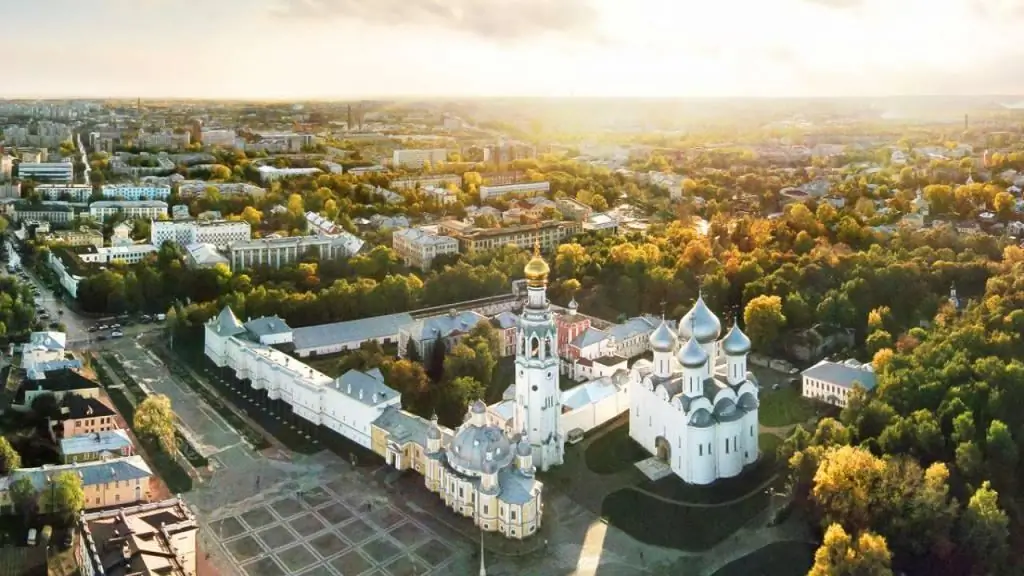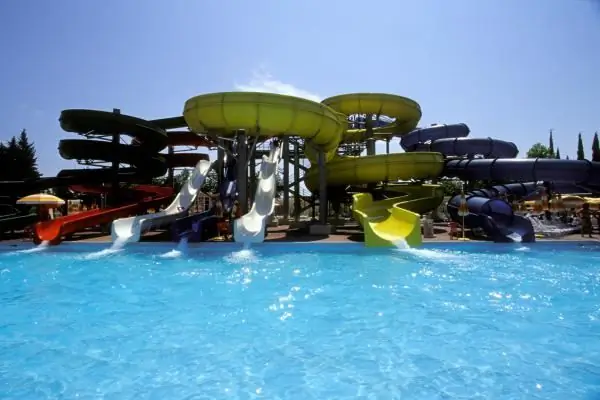- Author Harold Hamphrey [email protected].
- Public 2023-12-17 10:06.
- Last modified 2025-01-24 11:10.
Vilnius is one of the most popular cities in the B altics. Every year, millions of tourists from all over the world visit the capital of beautiful Lithuania. Many cities in Europe are very bright and noisy in spirit, but Vilnius is not at all one of those. It may seem inconspicuous, quiet, but very romantic and atmospheric.
Traditionally, most of the B altic capitals are limited to attractions in the Old Town, but this is definitely not about Vilnius. Many architectural monuments and structures are located outside this territory.
Vilnius is a city that has survived a whole galaxy of events. It was full of life already in the fifteenth century. Various handicrafts, gastronomic products were sold on the central streets, and missionaries belonging to the Catholic order walked around the noisiest districts.
The main part of history falls on the Middle Ages, so the construction of Vilnius attractions mostly refers to this period in the history of Lithuania.
Mainsights of the city
In this article we will tell you about the best attractions in Vilnius. It seems to many that in the capital cities of the B altic States there are no architectural structures at all. In fact, this is a big misconception. You will find out why in the following sections of the article.
Old City
Definitely worth starting from the Old City. After all, it was in this place that the history of the Lithuanian state began to emerge. All streets of quiet and calm Vilnius remind of medieval times. The most beautiful temples, souvenir markets, as well as restaurants with delicious traditional cuisine are hidden here.
Of course, the inner city in most capitals is very similar, but each of them has something special. Walking through this area will no doubt bring you endless pleasure and inspiration.
The Old Town is one of the most interesting sights in Vilnius.
Sharp Gate

Definitely one of the main architectural structures of the city. The monument has a second name - Aushros Gate. Previously, this place served as a shrine for pilgrims from all the B altic countries.
In the photo above, we can see the modern look of the monument. The gate with the chapel, as well as the image of the Mother of God, which is one of the main shrines of Christians, has been preserved.
I would like to note that the building was built in the second half of the seventeenth century. Then the chapel was made of wood, later it was rebuilt in stone.
Town Hall

The Town Hall is the most popular attraction in the city of Vilnius. Today, the administration is located inside the building. As you can see, the appearance of the architectural structure is very modest and inconspicuous, but this did not prevent the town hall from attracting the attention of millions of travelers from all over the world.
It is known that in the fourteenth century various concerts, balls, as well as performances by street musicians were held in this place. The first mention of the building itself appeared in the sixteenth century, but in those years the building looked more like a Gothic building, which you can’t say for sure now. By the way, the town hall is located on one of the oldest squares in the city, and the most beautiful streets lie around it. By right, it can be called the most popular attraction of Vilnius in the Old Town.
Piles Street

One of the oldest streets in the city. It is interesting that it runs along the entire city towards Moscow. It was on it that kings rode in their carriages, foreign figures entered the city, and street performers and musicians also moved. On the territory of Pilies there are many sights of old Vilnius. Among them are some galleries, famous souvenir shops, several museums and historical buildings.
Presidential Palace

This landmark of Vilnius can be seen on all magnets and postcards. Here is the residence of the President of the country. Formerly basedhigher clergy.
The building is rather young compared to others, as it was built in the eighteenth century. The author of the project is Laurynas Gucevicius. At that time he was a popular architect, a prominent representative of classicism. This building was built in the late classical style.
As you know, for several years the Lithuanian state was under the protectorate of Russia, and at that time the office of the Russian governor settled inside the presidential palace.
In addition, Prussian and Polish monarchs ruled at different times in this significant historical building.
Palace of the Grand Dukes of Lithuania

Here is the royal residence of the government of Lithuania. It was originally built near the Castle Hill in the fifteenth century, but subsequently destroyed due to merciless wars.
The palace was brought back to life only at the beginning of the twenty-first century, but it has retained its historical appearance. A museum was opened on the territory of the architectural structure.
An interesting fact is that the Palace of the Grand Dukes of Lithuania is the largest restoration project among the sights of Vilnius, as it is associated with the revival of the Lithuanian state.
St. Stanislaus Cathedral

The most important Catholic cathedral of the Lithuanian state, it was donated by the Vatican, therefore it received the status of a minor basilica. This status is conferred by the Pope. Externally, the monument is very reminiscent of the Greek pantheon.
Cathedrallocated in the heart of beautiful Vilnius, on the Castle Hill. The temple was built in the Middle Ages and has seen the coronation of many princes since Prince Vytautas.
An octagonal tower rises against the backdrop of the cathedral. According to historians, earlier it housed the altar of the god Perkunas. He belonged to the pagan gods.
Church of St. Anne and Bernardine Church

This building is a striking example of medieval architecture. It stands out among the graceful white historical monuments of Vilnius, as it was built in the Lithuanian Gothic style.
The building was originally built of wood (in the fourteenth century), but such an unprotected structure was destroyed and rebuilt more than once.
In the nineteenth century St. Anne's Church became one of the historical monuments of the State of Lithuania.
Next to the famous architectural monument is the Bernardine Church, built in the fifteenth century. The construction was carried out by the Franciscans. The Franciscans included a Catholic mendicant order that belonged to Francis of Assisi.
Church of Saint John

This temple is located on the territory of the main university. Almost like all religious buildings, the church is one of the sights of Vilnius. It is up to you to decide what is better to visit, since there is plenty to choose from. For a long time, the architectural structure belonged to the Jesuit order.
In the fifteenth century the church was built, but the workcontinued for over forty years. Most tourists are attracted by the bell tower, which is almost seventy meters high.
Previously, worship services were held on the temple grounds, as well as impromptu theatrical performances and coronations of kings. In addition, student protests were held there several times.
Gediminas' Tower

Like many attractions in the vicinity of Vilnius, the fifty-meter-high Gediminas' Tower is located on the Castle Hill, and can be seen from almost anywhere in the city.
Of course, every citizen knows about this place, as well as every tourist who has visited Lithuania at least once. After all, Gediminas Tower is one of the symbols of the capital.
It may seem to many that it looks unfinished. This is because it is a remnant of the Upper Castle built in the fifteenth century.
Inside the architectural monument is the National Museum. By visiting it, you can learn a lot of informative facts about the capital of Lithuania.
Gediminas Avenue

The most central street of the city. This landmark of Vilnius is especially beautiful in winter, as the authorities decorate it closer to Christmas and New Year. Therefore, it is during this period that most travelers come, because the climate in Vilnius is very favorable.
This street connects several main squares of the capital. Among them: Lukishskaya, Independence Square, Self-Government Square and Cathedral.
Prospect received this name quite recently, earlierit was called Stalin Avenue and also Lenin Avenue. It was later renamed. There are practically no residential buildings on the street, mainly here you can find administrative institutions, as well as government ones. This is what usually happens in most European cities.
Palace of the Radziwills

The palace is located in the old part of the city, on a small Vilniaus street. Travelers have nicknamed this building "Lithuanian Louvre" due to the fact that European paintings are exhibited inside the building.
As you can see, the palace was built in the late Renaissance style. Many sights in Europe are made in this manner. After all, this style was a key turning point in the history of architecture. It was preceded by medieval Gothic.
The building originally belonged to the most eminent family in Lithuania - the Radziwills. By the way, this surname was one of the first to receive a title in the country.
National Museum of Lithuania

Exhibits first appeared in the museum in the nineteenth century, and the author of the first exhibition was a well-known figure in the field of culture - Tyszkiewicz. Already in those years, more than fifteen thousand samples of fine art were collected. But because of the wars, most of them were moved to Moscow.
Conclusion
Vilnius is a romantic city with many interesting architectural structures that you want to see again. We strongly advise you to visit the capital of Lithuania during the frosty snowy season, because it is in winterthe sights of Vilnius look the most atmospheric.






